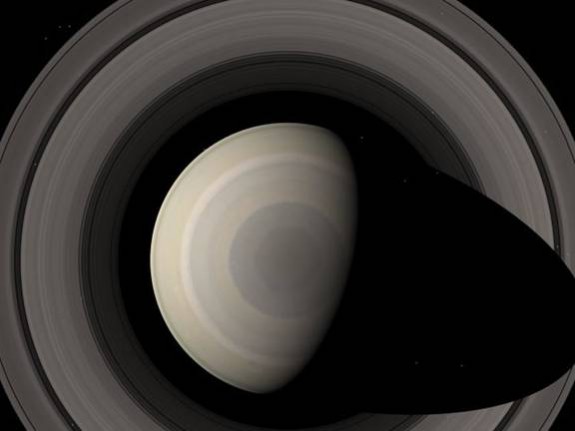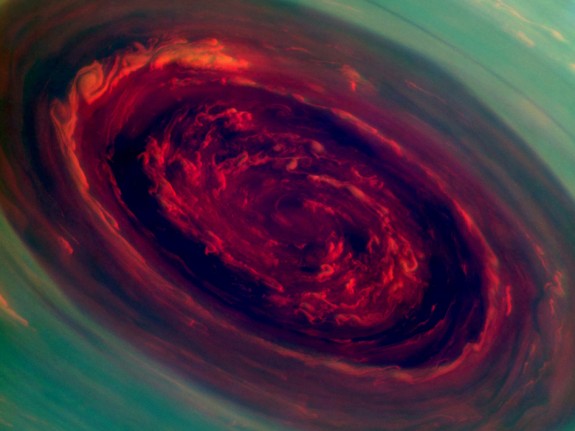Saturn’s Mysterious Hexagon Is a Raging Hurricane
At the heart of Saturn’s hexagon, a giant hurricane

A video stitched together from sequential photos of Saturn’s hexagon. Photo: NASA/JPL/Space Science Institute
Saturn changes seasons ever so slowly, and in 2009, after seven years of winter, the planet’s orbit tipped, bringing sunlight once more to Saturn’s north pole. The changing season offered astronomers the first good look at the region since the Sun began to wane in the mid-1990s, says Wired. And the break of first light provided a stunning view of a marvel that has baffled scientists since they first saw it in images captured by the Voyager spacecraft back in the 1980s, during Saturn’s most recent summer.
At the tip of Saturn’s north pole, there’s an oddly geometric hexagon: a wall of clouds with six distinct sides. Here’s what Voyager was able to document three decades ago:

Saturn’s hexagon as seen in the 1980s. Photo: NASA, seen through Universe Today
Wired, in 2009, explained what was so interesting about that figure:
“The longevity of the hexagon makes this something special, given that weather on Earth lasts on the order of weeks,” said Kunio Sayanagi, a Cassini project researcher at the California Institute of Technology, in a NASA release. “It’s a mystery on par with the strange weather conditions that give rise to the long-lived Great Red Spot of Jupiter.”
The hexagon circles Saturn at 77 degrees north and is wider than two Earths. Nearly everything about the weather pattern is baffling. First, it’s unclear what causes the hexagon. Second, it’s bizarre that the jet stream would make such sharp turns. Earth’s atmospheric movements rarely display such geometric rigor.
But now, says NASA, improvements in satellite sensors and a bit better timing gave scientists working with the Cassini satellite a view into the very heart of the storm. There, they discovered something surprising: a gigantic hurricane.

Photo: NASA/JPL-Caltech/SSI
Though 20 times larger than an average Terran twister, the hurricane is very similar to the ones we see on Earth. Both have central eyes with low-hanging clouds surrounded by a wall of higher clouds spiraling around. Saturn’s hurricane winds are four times stronger than those on Earth, whipping by at 530 kmph (330 mph). Cyclones on our planet also tend to move around but Saturn’s polar storm has nowhere to go, remaining stuck in place for years.
As Saturn edges ever more into summer, an opportunity for scientific study of the storm—and hopefully more gorgeous photos—should emerge.
More from Smithsonian.com:
/https://tf-cmsv2-smithsonianmag-media.s3.amazonaws.com/accounts/headshot/smartnews-colin-schultz-240.jpg)
/https://tf-cmsv2-smithsonianmag-media.s3.amazonaws.com/accounts/headshot/smartnews-colin-schultz-240.jpg)